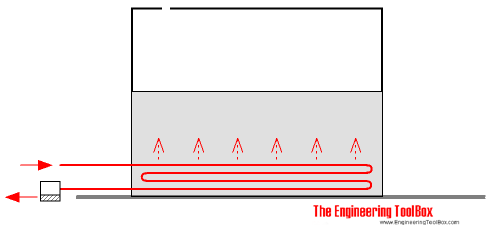Pipes Submerged in Oil or Fat - Heat Emission (original) (raw)
Heat emission from steam or water heating pipes submerged in oil or fat - forced and natural circulation.
The viscosity of a fluid has considerable influence on the heat transfered from a submerged heating pipe. Be aware that the viscosity of a fluid is highly dependent on the temperature.

Heat emission from steam pipes submerged in oil baths are indicated below:
Pipes Submerged in Oil or Fat - Heat Emission
| Application | Fluid | Heat Emission from coil surface | |
|---|---|---|---|
| (Btu/ft2 hr oF) | (W/m2 oC) | ||
| Steam coil with medium steam pressure and natural convection of oil | Light Oils | 30 | 170 |
| Heavy Oils | 15 - 20 | 85 - 115 | |
| Fats | 5 - 10 | 30 - 60 | |
| Steam coil with medium pressure and forced convection of oil | Light Oils | 100 | 570 |
| Heavy Oils | 60 | 340 | |
| Fats | 30 | 170 |
- Light oils - 220 SSU at 100 oF
- Heavy oils - 1100 SSU at 100 oF
- Fats - 3833 SSU at 100 oF
- Carbon, Alloy and Stainless Steel Pipes - ASME/ANSI B36.10/19 - dimensions
- Outside surface area - pipe equations
Example - Heat Emission from a 2" Coil in a Fat Tank
A 10 m long 2" inch stainless steel steam coil heats a tank with fat. The steam pressure is 1 bar and the temperature in the coil is 120 oC. The temperature in the tank is 40 oC. The convection is natural with heat emission 50 W/m2oC.
The outside diameter of the pipe is 60.3 mm and the external surface of the pipe pr. m length of pipe can be calculated as
As = 2 π ((0.063 m) / 2) (1 m)
= 0.2 m2/m pipe
The heat emission from the coil as whole can be calculated as
Q = (10 m) (0.2 m2/m pipe) (50 W/m2oC) ((120 oC) - (40 oC))
= 8000 W
= 8 kW
Related Topics
Design of heating systems - capacities and design of boilers, pipelines, heat exchangers, expansion systems and more.
Heat loss from uninsulated and insulated steam and condensate pipes and tanks. Calculate insulation thicknesses.
Design of steam & condensate systems with properties, capacities, sizing of pipe lines, system configuration and more.
Related Documents
Specific heat of common food and foodstuff like apples, bass, beef, pork and many more.
Autoignition points for fuels and chemicals like butane, coke, hydrogen, petroleum and more.
Heat loss from insulated and non insulated sheltered and exposed oil tanks and pipes.
Kinematic viscosities of some common liquids like motor oil, diesel fuel, peanut oil and many more.
Specific heats for some common liquids and fluids - acetone, oil, paraffin, water and many more.
Heat loss from insulated and uninsulated, sheltered and exposed heated oil tanks.
Heat loss from lagged and unlagged, sheltered and exposed oil tanks.
Heat loss vs. surface temperature.
Conductive heat losses through cylinder or pipe walls.
Heat emision from steam or water heating pipes submerged in water - assisted (forced) or natural circulation.
Specific heat of products like wet mud, granite, sandy clay, quartz sand and more.
Heat loss from steel pipes and tubes - dimensions 1/2 to 12 inches.
Heat transfer coefficients for steam and hot water coils submerged in oil tanks.
Vicosity is a fluid's resistance to flow and can be valued as dynamic (absolute) or kinematic.
Thermal properties of water at different temperatures like density, freezing temperature, boiling temperature, latent heat of melting, latent heat of evaporation, critical temperature and more.
About the Engineering ToolBox!
Privacy Policy
We don't collect information from our users. More about
We use a third-party to provide monetization technologies for our site. You can review their privacy and cookie policy here.
You can change your privacy settings by clicking the following button: .
Citation
This page can be cited as
- The Engineering ToolBox (2003). Pipes Submerged in Oil or Fat - Heat Emission. [online] Available at: https://www.engineeringtoolbox.com/heat-emission-steam-pipes-oil-d\_288.html [Accessed Day Month Year].
Modify the access date according your visit.